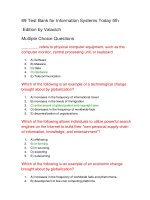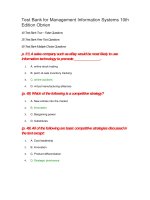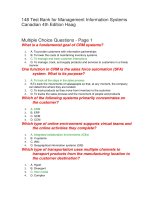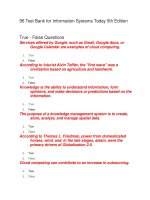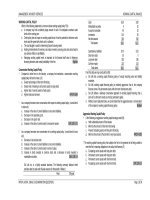TEST BANK management information systems 0408
Bạn đang xem bản rút gọn của tài liệu. Xem và tải ngay bản đầy đủ của tài liệu tại đây (254.24 KB, 13 trang )
Suggested Answers with Examiner's Feedback
Page 1 of 13
Question Paper
Management Information Systems (MC261) : April 2008
Section A : Basic Concepts (30 Marks)
This section consists of questions with serial number 1 - 30.
Answer all questions.
Each question carries one mark.
Maximum time for answering Section A is 30 Minutes.
<Answer>
1. The data in the DSS database
(a)
Are provided by middle management
(b)
Use data mining
(c)
Are based on system models
(d)
Generally copies of production databases
(e)
Are provided by Top-level management.
<Answer>
2. In an organization business processes produce
(a)
Product
(b)
Knowledge
(c)
Information
(d)
Project
(e)
All of the above.
3. Which of the following is the type of electronic commerce that involves consumers selling directly to <Answer>
consumers?
(a)
B2C
(b)
B2B
(c)
C2C
(d)
Virtual Storefront
(e)
Electronic bartering.
Which
one
of these best describes the role of a manager?
<Answer>
4.
(a)
Attending meetings, attending corporate luncheons, disciplining staff, representing the company
(b)
Planning, organizing, coordinating, making decisions, controlling
(c)
Maintaining a rigid position in the hierarchy to prevent customer complaints from coming to the
attention of the Board
(d)
Supervising the work of junior staff
(e)
Maintaining the work flow and coordination of the work.
Systems
that maintain employee records: track employee skills, job performance, and training; and support<Answer>
5.
planning for employee compensation and career development best describes
(a)
Sales and marketing information systems
(b)
Manufacturing and production information systems
(c)
Finance and accounting information systems
(d)
Human resources information systems
(e)
Economic systems.
6. Top managers use a ----------, as a combination of MIS and DSS, to support their decision making.
(a)
(b)
(c)
(d)
(e)
GIS
ESS
Expert System
GDSS
TPS.
7. An example of input of an information system would be
(a)
(b)
(c)
(d)
(e)
<Answer>
Sales trend forecast
Inventory report
Customer’s information
Summary of customer’s preferences analyses
None of the above.
8. Which of the following is not a key information system component?
(a)
(b)
<Answer>
<Answer>
Design stability
Data
file://C:\Documents and Settings\Administrator\Desktop\Question Paper\Group F\Ma... 02/07/2008
Suggested Answers with Examiner's Feedback
(c)
(d)
(e)
Page 2 of 13
Data flow
Processing logic
Input and output.
9. Which of the following is not one of the four major classes of information systems?
(a)
(b)
(c)
(d)
(e)
Decision support system
Collaboration system
Management information system
Expert system
Transaction processing system.
10.Drawing on diverse yet predictable data resources to aggregate and summarize data is characteristic of
(a)
(b)
(c)
(d)
(e)
<Answer>
Management replication system
Management information system
Expert system
Decision support system
Collaboration system.
12.Making repeated changes to selected variables until a chosen variable reaches a target value is called as
(a)
(b)
(c)
(d)
(e)
<Answer>
Management information system
Decision support system
Expert systems
Transaction processing system
Collaboration system.
11.Which of the following replicates the decision-making process rather than manipulates information?
(a)
(b)
(c)
(d)
(e)
<Answer>
<Answer>
What- if analysis
Sensitivity analysis
Goal-Seeking analysis
Optimization analysis
Process analysis.
13.What level of decision is appropriate for a manufacturing industry, if it involves rearranging the work area,<Answer>
altering production schedules, changing inventory methods or expanding quality control measures?
(a)
(b)
(c)
(d)
(e)
Operational
Tactical
Strategic
Both (a) and (c)
All of the above.
14.The purpose of decision support systems is to
(a)
(b)
(c)
(d)
(e)
<Answer>
Replace a manager’s judgment during the decision-making process
Provide a predefined sequence of analysis during the process of problem solving
Provide interactive assistance during the process of problem solving
Automate a manager’s decision-making process
All of the above.
15.Electronic data interchange, E-mail, Extensible Markup Language (XML), Fax and Market size are the examples<Answer>
related to which of the following Hubs?
(a)
(b)
(c)
(d)
(e)
Collaboration Hubs
Aggregator Hubs
Translator Hubs
Broker Hubs
Both (a) and (b) above.
16.Strategic changes often involve
(a)
(b)
(c)
(d)
(e)
Applying for funds from a bank before changes are considered
Laying off old employees before changes are made
Hiring new IS teams before any of the competitors
Implementing new technology before any of the competitors
All of the above.
17.When developing and choosing strategies, you must always remember that
(a)
(b)
<Answer>
<Answer>
Innovations are free from risks and often do not carry high capital costs
Innovations carry low capital costs and always lead to a successful business
file://C:\Documents and Settings\Administrator\Desktop\Question Paper\Group F\Ma... 02/07/2008
Suggested Answers with Examiner's Feedback
(c)
(d)
(e)
Page 3 of 13
Innovations can be risky and often carry high capital costs
Innovations always take away money from other projects
Innovation carry low capital costs and often risky.
18.The Insurance renewal rate calculation system which has a standard set of decision rules uses
(a)
(b)
(c)
(d)
(e)
Representation models
Accounting models
Suggestion models
Optimization models
Data analysis systems.
19.Information systems can facilitate supply chain management by
(a)
(b)
(c)
(d)
(e)
<Answer>
Group Consensus
Guided Brainstorming
Brainstorming
Closed Question
Open Questions.
21.What is the interactive, computer-based information system that collects data on transactions and operations?
(a)
(b)
(c)
(d)
(e)
<Answer>
Tracking the status of orders
Rapidly communicating orders
Providing product specifications
Processing orders
All of the above.
20.Delphi method and group norming are examples of
(a)
(b)
(c)
(d)
(e)
<Answer>
<Answer>
Transaction processing system
Decision support system
Executive information system
Expert system
MIS.
22.Banks are very much dependent on technology to provide better customer service. In order to automate<Answer>
operations and reduce the transaction time banks has to use information technology. Which type of quadrant in
the information planning grid will best suit the above given example?
(a)
(b)
(c)
(d)
(e)
Turnaround
Factory
Strategic
Support
All of the above.
23.A marketplace that is created by computer and communications technologies, that link many buyers and sellers<Answer>
define as
(a)
(b)
(c)
(d)
(e)
Mobile commerce
The internet
Digital markets
The world wide web
Electronic commerce.
24.Using advanced graphics and communications to address unstructured decision making is an example of an <Answer>
information system at
(a)
The operational level
(b)
The knowledge level
(c)
The management level
(d)
The strategic level
(e)
All of the above.
25.A model of decision making stating that organizations are not rational and that decisions are solutions that<Answer>
become attached to problems for accidental reasons best describes the
(a)
Irrational model of decision making
(b)
Bureaucratic model of decision making
(c)
Organizational model of decision making
(d)
Systematic model of decision making
(e)
"Garbage can" model of decision making.
26.The most successful solutions or problem-solving methods that have been developed by a specific organization <Answer>
file://C:\Documents and Settings\Administrator\Desktop\Question Paper\Group F\Ma... 02/07/2008
Suggested Answers with Examiner's Feedback
Page 4 of 13
or industry best describes
(a)
(b)
(c)
(d)
(e)
Best practices
Knowledge management
Standard operating procedures
Explicit knowledge
Business objectives.
27.Which of the following is a network of facilities for procuring materials, transforming raw materials into <Answer>
intermediate and finished products and distributing the finished products to customers?
(a)
(b)
(c)
(d)
(e)
Supply chain
Production chain
Distribution chain
Value chain
Primary chain.
<Answer>
28.Why do computer projects in MIS need to be carefully managed?
(a)
(b)
(c)
(d)
(e)
Computer professionals are rather disorganized people
Many specialist skills are needed, which have to be coordinated
MIS systems are powerful bits of software that make decisions
The hardware is complex to be set
All of the above.
29.The process of helping users, see patterns and relationship in large amounts of data by presenting the data in <Answer>
graphical form is called
(a)
(b)
(c)
(d)
(e)
GIS
Data visualization
DSS
An optimization model
MIS.
<Answer>
30.The most common models in a DSS software system are
(a)
(b)
(c)
(d)
(e)
Libraries of statistical models
Statistical graphs from multiple information sources
Optimization models
OLAP tools
OLTP tools.
END OF SECTION A
Section B : Problems/Caselets (50 Marks)
This section consists of questions with serial number 1 – 5 .
Answer all questions.
Marks are indicated against each question.
Detailed workings/explanations should form part of your answer.
Do not spend more than 110 - 120 minutes on Section B.
<Answer>
1. What is the role of the MIS in an organization and its impact on the organization’s
functions?
( 10 marks)
<Answer>
2. Explain the different categories of key variables. What are the steps that can help in
identifying key variables?
( 10 marks)
Caselet 1
Read the caselet carefully and answer the following question:
<Answer>
3. What were the organizational impacts of the LAN and how well were they managed?
How successful were the Royal Mail in managing the implementation of the LAN?
( 15 marks)
The Post Office is a group of 3 core businesses that form the UK’s national postal
system. It operates as a public corporation and is owned, but not managed, by the
Government. Its businesses are: (1) Royal Mail: the letters business, (2) Post Office
Counters Limited: the retail business and (3) Parcelforce: the parcels business. It also
file://C:\Documents and Settings\Administrator\Desktop\Question Paper\Group F\Ma... 02/07/2008
Suggested Answers with Examiner's Feedback
Page 5 of 13
runs Subscription Services Limited, which provides a portfolio of services to UK
businesses.
The group as a whole has recorded a profit for the last 19 years, and is one of the few
national postal administrations to operate without government subsidy. In 1994,
following a review set up two years earlier, the Government published a discussion
paper that set out proposals for the future of the Post Office. Mr. PETER LILLEY, trade
and industry secretary, used an Adam Smith Conference on postal services to make clear
yesterday, that his proposals to inject more competition into the Post Office did not
amount to wholesale privatization. While restating his determination to liberalize postal
services, he frequently referred to the government’s commitment to a nation-wide letter
service with a uniform, affordable price structure. Following a prolonged and intense
public debate the Government decided, in 1995, to drop plans for Royal Mail/Parcelforce
privatization from its then current legislative programme but in the following year
announced it was relaxing some of the financial restraints to allow the Post Office
businesses to compete for new business.
The Post Office is to shed more than 15,000 jobs as a result of increased automation in
its sorting offices. The reductions will cut the number of sorting office staff by a third
and will be implemented within the next three years. They are in addition to 2,000
redundancies among middle managers in the past six months. Details of the job losses
are incorporated in confidential minutes of the Post Office Board which heard a Union
leaders fear that the reductions could also lead to the closure of a number of the 40 large
sorting offices. Workers at three London offices have been warned to expect a decision
on their future by the end of next month. The work of at least one, King Edward’s near
St Paul’s Cathedral, is almost certain to be relocated.
The Post Office said yesterday, it was a question of ‘technology replacing jobs’. The
machinery would enable Royal Mail to cope with an expected 18 per cent growth in
business in the next five years. It was also expected to improve the quality of service by
three percentage points to 93 per cent. Productivity in letter delivery had improved, with
a rise of 50 per cent in the numbers of items handled in the past 10 years. The increase in
the volume of mail has allowed the Post Office the breathing space to adjust its staffing
requirements without the need for any compulsory redundancies.
The Royal Mail was about to embark on a “business development” - restructuring that
would reduce the 64 postal districts that existed then to 9 new geographical divisions.
What was then the Newcastle upon Tyne postal district would soon become the North
Eastern postal division.
The concerns are related to the introduction of a Local Area Network in the Newcastle
upon Tyne postal district/North Eastern postal division office. A Local Area Network
(LAN) had been introduced in the Newcastle upon Tyne postal district 18 months earlier
and was intended to link together different locations in the Newcastle area and to provide
a gateway to other Post Office LAN’s nation wide.
Initially use of this system was restricted to senior (board level) managers but with the
impending restructuring and expected privatization use of the LAN was extended to
other levels in the organization. Initially there were 37 terminals in the Newcastle area
and 6 at ‘remote sites’. The Newcastle LAN could also be used to link to another 20 Post
Office LAN’s in different parts of the country. The system integrated elements of
personnel, administration, recruitment and data on human resource utilization with data
on costing and the volume of business transactions.
END OF
CASELET 1
Caselet 2
Read the caselet carefully and answer the following questions:
<Answer>
4. “It is one thing to have ownership of your own computer systems but another to accept
the responsibilities of ownership such as data integrity, security and overall risk
management.” This was a statement made by the financial director of hospitals at a
regional medical conference attended by Medclinic management.
Indicate how Medclinic would ensure that its ‘responsibilities of ownership’ are properly
carried out?
( 8 marks)
<Answer>
5. An initial investigation of other medical centres similar to Medclinic has revealed that
some have opted for a minicomputer supporting a series of terminals while others have
adopted an information technology approach based on networked personal computers.
Explain these two configurations and briefly discuss their suitability for Medclinic’s
file://C:\Documents and Settings\Administrator\Desktop\Question Paper\Group F\Ma... 02/07/2008
Suggested Answers with Examiner's Feedback
Page 6 of 13
operations.
( 7 marks)
The
Medclinic
Health
Centre
is
located
in
a
small
market
town
with
a
population
of
approximately 10,000. The centre provides general medical care plus limited support
services such as a small operating theatre, a laboratory for specimen testing and a
radiography unit for X-rays. Medical care is on a day care only basis there being no
facilities for overnight hospitalisation. Longer stay medical care is provided at the
regional hospital some 30 miles away.
The centre is staffed by 10 doctors on a shift basis, who also provide emergency cover
when the centre is closed on Sunday and during the night. The doctors are supported by
four nurses. Administrative systems which include patient records, staff records, and
substantial correspondence between doctors, patients and consultants are undertaken by
two full time and four part-time secretaries. The centre operates an appointment system
for patients seeking non-urgent treatment. The system is operated by 12 part-time
receptionists working on a shift system.
In addition, the centre employs a radiographer and three laboratory technicians. The
laboratory technicians are also responsible for ordering, maintaining and issuing drugs
from the stocks held at the centre.
At present time the payroll, income receipts and expenditure payments procedures for
the Medclinic centre are undertaken on the mainframe system at the regional hospital
computer centre. All Medclinic centre administrative, text and record keeping
procedures are operated manually. There is, however, a terminal link between the centre
and the regional hospital which is used to input accounting transaction data, order drugs
and transmit medical statistical data for national health monitoring. The Medclinic centre
and all medical centres under the regional hospital will soon be responsible for their own
financial affairs. The senior doctors at Medclinic see this as an opportunity to
computerize not only the financial systems which will now be necessary but many of
Medclinic’s administrative and record keeping procedures.
The doctors are fully supported in this initiative by the nursing and administrative staff.
The support staff feel overwhelmed by the present volumes of paperwork but are very
apprehensive at the prospect of taking responsibility for Medclinic’s financial and
associated systems.
END OF CASELET 2
END OF SECTION B
file://C:\Documents and Settings\Administrator\Desktop\Question Paper\Group F\Ma... 02/07/2008
Suggested Answers with Examiner's Feedback
Page 7 of 13
Section C : Applied Theory (20 Marks)
This section consists of questions with serial number 6 - 7 .
Answer all questions.
Marks are indicated against each question.
Do not spend more than 25 -30 minutes on Section C.
6.
List the decisions involved in each phase of the management process, starting from
planning to control?
( 10 marks) <Answer>
7.
Explain about the integration of multi technique tools used in the construction of
DSS.
( 10 marks) <Answer>
END OF SECTION C
END OF QUESTION PAPER
file://C:\Documents and Settings\Administrator\Desktop\Question Paper\Group F\Ma... 02/07/2008
Suggested Answers with Examiner's Feedback
Page 8 of 13
Suggested Answers
Management Information Systems (MC261) : April 2008
Section A : Basic Concepts
Answer
Reason
B
The data in the DSS database use data mining
1.
C
In an organization business processes produce Information.
2.
B
B2B is the type of electronic commerce that involves consumers selling directly to
3.
consumers.
B
Planning, organizing, coordinating, making decisions, controlling describe the role of a
4.
manager.
D Systems that maintain employee records; track employee skills, job performance, and
5.
training; and support planning for employee compensation and career development best
describes human resources information systems.
B
Top managers use a ESS as a combination of MIS and DSS, to support their decision
6.
making.
C
An example of input of an information system would be Customer’s information.
7.
A
Design stability is not a key information system component.
8.
B
Collaboration system is not one of the four major classes of information systems.
9.
B
Drawing on diverse yet predictable data resources to aggregate and summarize data is
10.
characteristic of decision support systems.
D Decision support system replicates the decision-making process rather than anipulates
11.
information.
C
Making repeated changes to selected variables until a chosen variable reaches a target
12.
value is called as Goal-Seeking analysis.
A Operational level of decision is appropriate for a manufacturing industry if it involves
13.
rearranging the work area, altering production schedules, changing inventory methods, or
expanding quality control measures.
D The purpose of decision support systems is to Automate a manager’s decision-making
14.
process.
C
Electronic data interchange, E-mail, Extensible Markup language (XML) and Fax and
15.
market size are the examples related to the Translator Hubs.
D Strategic changes often involve Implementing new technology before any of your
16.
competitors.
B
When developing and choosing strategies, we must always remember that Innovations
17.
carry low capital costs and always lead to a successful business.
C
The Insurance renewal rate calculation system which has a standard set of decision rules
18.
uses Suggestion models.
A Information systems can facilitate supply chain management by Tracking the status of
19.
orders.
A Delphi method and group norming are examples of Group Consensus.
20.
A Transaction processing system is the interactive, computer-based information system that
21.
collects data on transactions and operations.
C
Strategic type of quadrant in the information planning grid will best suit the above given
22.
example.
C
A marketplace that is created by computer and communications technologies that link
23.
many buyers and sellers defines a digital markets.
D The strategic level is an example of an information system that uses advanced graphics
24.
and communications to address unstructured decision making.
E
A model of decision making stating that organizations are not rational and that decisions
25.
are solutions that become attached to problems for accidental reasons best describes the
garbage can model of decision making.
A The most successful solutions or problem-solving methods that have been developed by a
26.
specific organization or industry best describes best practices.
A Supply chain is a network of facilities for procuring materials, transforming raw materials
27.
into intermediate and finished products, and distributing the finished products to
< TOP >
< TOP >
< TOP >
< TOP >
< TOP >
< TOP >
< TOP >
< TOP >
< TOP >
< TOP >
< TOP >
< TOP >
< TOP >
< TOP >
< TOP >
< TOP >
< TOP >
< TOP >
< TOP >
< TOP >
< TOP >
< TOP >
< TOP >
< TOP >
< TOP >
< TOP >
< TOP >
file://C:\Documents and Settings\Administrator\Desktop\Question Paper\Group F\Ma... 02/07/2008
Suggested Answers with Examiner's Feedback
28.
B
29.
B
30.
A
Page 9 of 13
customers.
Many specialist skills are needed, which have to be coordinated because computer < TOP >
projects in MIS need to be carefully managed
Data Visualization is a process which helps the users to see patterns and relationship in < TOP >
large amounts of data in a graphical form.
< TOP >
Libraries of statistical models are the most common models in a DSS software system.
file://C:\Documents and Settings\Administrator\Desktop\Question Paper\Group F\Ma... 02/07/2008
Suggested Answers with Examiner's Feedback
Page 10 of 13
Section B : Problems
1.
2.
Role of MIS in an organization:
< TOP >
The management information system ensures that proper data is collected from various sources,
processed and subsequently sent to all the destinations that require the information. It fulfills the
information needs of a person, a group of persons, the managers and the top management. It
satisfies their needs through the following systems such as query systems, analysis systems,
decision support systems and modeling systems. It helps in strategic planning, management
control, operational control and transaction processing.
Impact of MIS
In an organization, the management of marketing, finance, production and personnel will become
efficient with a good MIS support. The functional managers can be informed about the progress,
achievements and shortfalls in the activity and targets. By providing the information about the
probable trends in the various business aspects, the manager can be kept alert and it helps in
forecasting and long-term perspective planning. The manager’s attention can be brought to a
situation that will make him to take an action or a decision in the matter.
We can classify key variables broadly into the following categories such as strategy, structural, < TOP >
process and environmental. If there is similarity between the different variables, performance of
an organization will be improved.
Strategy variables refer to the long-term choices concerning the programs, goals, policies
and action plans that are formulated by an organization.
Structural variables can be studied in terms of the structure of the organization: centralized
or decentralized form of organization and the organizational autonomy. Thus they represent
the organizational arrangements and the distribution of authority and relationships.
Process variables refer to processes that influence the behavior of the employees towards
the achievement of organizational goals. Some examples of process variables are the
participation, monitoring and control, human resource development and motivation.
Environmental variables help in understanding the scope, diversity and uncertainty relating
to an organization.
When all these variables are perfectly aligned then can organization can achieve congruence of its
performance with its goals. The following steps will help in the identification of the key variables:
Identification of decision variables
Interactions with the environment
Implications for the control structure
3.
4.
5.
Key success and the control paradigm
The introduction of a Local Area Network in the Newcastle upon Tyne postal district/North < TOP >
Eastern postal division and consists of interviews with eight members of staff there. A Local Area
Network (LAN) had been introduced in the Newcastle upon Tyne postal district 18 months earlier
and was intended to link together different locations in the Newcastle area and to provide a
gateway to other Post Office LAN’s nation wide.
Initially use of this system was restricted to senior (board level) managers but with the impending
restructuring and expected privatisation use of the LAN was extended to other levels in the
organisation. At the time of the interviews there were 37 terminals in the Newcastle area and 6 at
‘remote sites’. The Newcastle LAN could also be used to link to another 20 Post Office LAN’s in
different parts of the country.
The system integrated elements of personnel, administration, recruitment and data on human
resource utilisation with data on costings and the volume of business transactions.
All Medclinic centre administrative, text and record keeping procedures are operated manually.
< TOP >
The Medclinic centre and all medical centres under the regional hospital will soon be responsible
for their own financial affairs. The senior doctors at Medclinic see this as an opportunity to
computerise not only the financial systems which will now be necessary but many of Medclinic’s
administrative and record keeping procedures.
The doctors are fully supported in this initiative by the nursing and administrative staff. The
support staff feel overwhelmed by the present volumes of paperwork but are very apprehensive at
the prospect of taking responsibility for Medclinic’s financial and associated systems.
The mainframe system which was used at the regional hospital computer centre is helpful in < TOP >
preparing payroll, income receipts and expenditure payments for the Medclinic centre.
file://C:\Documents and Settings\Administrator\Desktop\Question Paper\Group F\Ma... 02/07/2008
Suggested Answers with Examiner's Feedback
Page 11 of 13
A terminal link between the centre and the regional hospital which is used to input accounting
transaction data, order drugs and transmit medical statistical data for national health monitoring.
Section C: Applied Theory
6.
The management process is executed through a variety of decisions taken at each step of planning, < TOP >
organizing, staffing, directing, coordinating and control and the MIS aids decision making. The
objective of the MIS is to provide information for a decision support in the process of
management. The decisions required to be taken through the above mentioned steps are tabulated
as under:
Management Steps
Planning
Organization
Staffing
Directing
Coordinating
Controlling
7.
Decision to be taken
A selection from the following various alternatives
such as strategies, resources ,methods etc.
A selection of a combination out of several
combinations of the goals, people, resources, method
and authority.
To provide a proper manpower complement.
To choose a method from the various methods of
directing the efforts in the organization.
To make a choice of the tools and the techniques for
coordinating the efforts for optimum results.
To make a selection of the exceptional conditions and
the decision guidelines.
Five types of multi technique integration of tools are used in the construction of the DSS. It is < TOP >
relevant whenever multiple knowledge management techniques are employed within the bounds of
a single DSS. These techniques may be integrated within a single tool or across multiple tools.
These five integration styles have various advantages and disadvantages relative to each other. It is
not unusual for more than one of them to be employed in a single DSS. These tools involving:
Knowledge - represented in a certain format. (K)
Knowledge manipulation-depends on a certain format
Program - devised to manipulate knowledge organized in a certain way (part or whole of a
PPS).
Knowledge transfer- from one repository to another (possibly reorganizing it)
The five technique tools are
1. Integration via knowledge format conversion.
2. Integration via a clipboard
3. Integration via a common format
4. Integration via nesting
5. Synergistic integration
Integration via knowledge format conversion
Conversion utility or import/export facility
As number of programs increase, number of utilities becomes large.
Knowledge transfer takes time and effort.
Knowledge manipulation requires program switching.
PPS may be developed to handle transfers and switching
Redundancy can lead to consistency problems
file://C:\Documents and Settings\Administrator\Desktop\Question Paper\Group F\Ma... 02/07/2008
Suggested Answers with Examiner's Feedback
Page 12 of 13
Integration via a clipboard
Common intermediate format (“clipboard”)
It requires fewer conversion utilities.
Knowledge transfer involves “cut/copy” and “paste”.
Programs may be able to directly manipulate clipboard contents
Knowledge manipulation equerries program switching
Redundancy can lead to consistency problems
Integration via a Clipboard
Integration via a common format
All programs designed to manipulate common format
No knowledge transfer required
Program switching still needed
Reduces redundancy/consistency problems
Difficult/inefficient to devise a single format for diverse software functionality (difficult to
implement-single format required for universal processing)
Integration via nesting
Prior approaches use knowledge as “glue” that binds diverse software functionality’s. Alternative
is to incorporate functionality’s of diverse techniques into a single tool. One way to do this is to
nest capabilities within a single program. One dominant component, plus secondary components
do switching among programs. No need for knowledge transfer. Must know the dominant
technique and dominant component constrains use of others.
file://C:\Documents and Settings\Administrator\Desktop\Question Paper\Group F\Ma... 02/07/2008
Suggested Answers with Examiner's Feedback
Page 13 of 13
Synergistic integration
Alternative to nesting is synergistic integration. It is a single program without a dominant
functionality. It can be used independent of others, but without switching. It can use multiple
techniques in a single operation thus traditional dividing lines among techniques blur. One
program that manipulates knowledge represented in multiple formats (even for a single request). It
avoid limitations of being restricted to a single format.
Combination
Select tools and integrate across them using foregoing approaches. Select tool in which needed
techniques are integrated.
< TOP OF THE DOCUMENT >
file://C:\Documents and Settings\Administrator\Desktop\Question Paper\Group F\Ma... 02/07/2008
